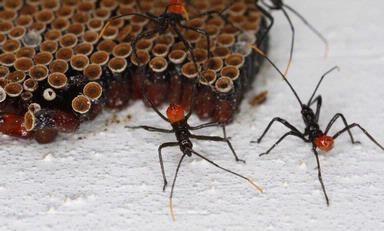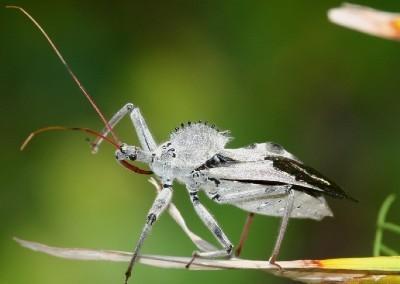About assassin bugs
-
Assassin bugs are generalist predators that feed on a wide variety of pests ranging from small ones like aphids to larger ones like caterpillars.
-
These patient hunters may either stalk their prey, or quietly wait for an appetizing insect to cruise by, then suddenly attack with their dagger-like, piercing-sucking beak.
-
Assassin bugs are generally larger and have longer legs than most other bugs, and have beady round eyes well suited for spotting prey.
-
They are important predators in the home garden, but handle them with care as large species will bite humans as well as their prey!
-
There are over 160 species of assassin bugs in North America, most of which survive the winter as adults in sheltered locations.
Important species in Maryland: Spined assassin bug, wheel bug, elongate assassin bug.
Life stage(s) that feed on pests: Nymphs and adult.

Assassin bug nymphs. Photo: Joseph Berger, Bugwood.org
Insect(s) fed on: Aphids, leafhoppers, asparagus beetle eggs and larvae, small flying insects, and up to medium-sized caterpillars. Some species in the genus Apiomerus hunt and eat bees.
Appearance of assassin bugs
Eggs: Laid in tight, upright clusters on bark, leaves, or in soil.
Nymphs: Resemble smaller, wingless adults.
Adults: Moderately large (usually 1/2 to 3/4" long; wheel bug may be up to 1 1/4”); most have a long, narrow body, with a long narrow head and a distinct “neck”; all have a pronounced “snout” with a long needle-like beak carried tucked up beneath the body; usually brownish, blackish, or gray (some elongate assassin bugs are bright green or red, with dark markings). The wheel bug has a distinctive semicircular crest, or “cogwheel”, on the upper back.

Wheel bug (type of assassin bug). Photo: Photo: Johnny N. Dell, Bugwood.org
Where to find: Most garden plants, field crops, ornamental trees and shrubs. Spined assassin bugs are often found on goldenrod and other wildflowers.
How to conserve: Avoid use of broad spectrum insecticides. Plant flowers and plants that attract a variety of other insects.
Contributors: Mike Raupp, Jon Traunfeld, and Chris Sargent
